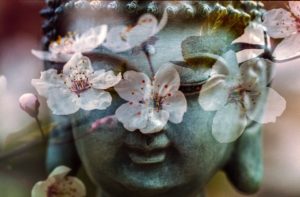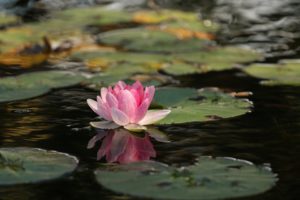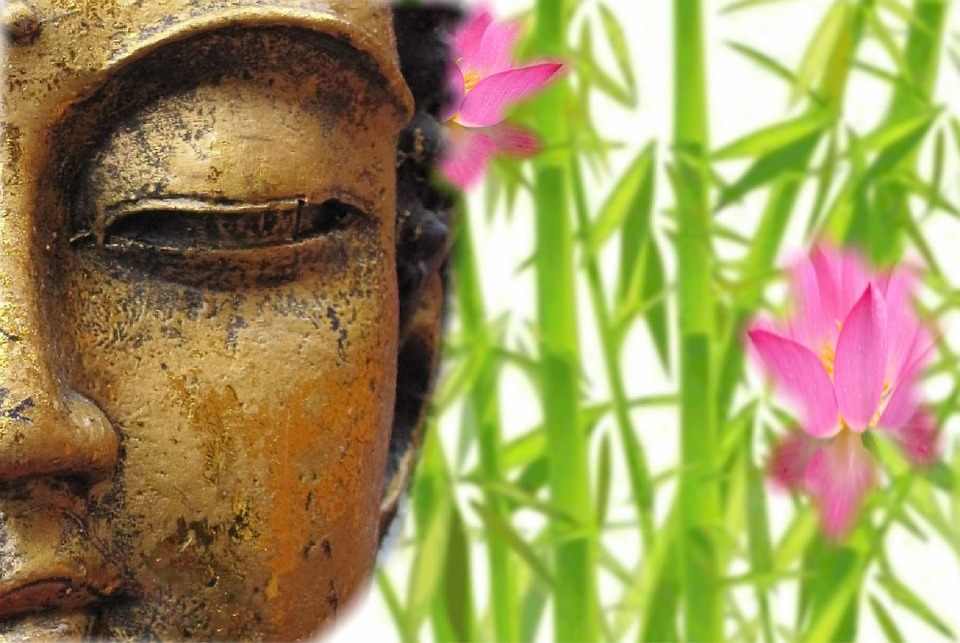‘Nenge-misho’ is Japanese for “smiling and twirling a flower [between the fingers]. ” ‘Nenge-misho’ is popularly known in English as ‘The Flower Sermon’ or ‘The Flower Sutra’.
In respects to the direct transmission of Buddha’s enlightenment or awakening, this fourteenth century sutra is arguably the most important event in the teaching life of Sakymuni Buddha and the advancement of the Mahayana school of Zen Buddhism. The argument is simply that like Jesus, Buddha’s followers did not record his teachings until after his death, so, it is often contended that The Flower Sutra is mythic and metaphoric rather than historic and fundamental.
 Theoretically, it is my literary responsibility to offer this information of myth versus history as a context by which to judge the veracity of statements contained within the recorded event. However, myth, history, pearls before swine, or a lotus flower – in Buddha-speak all are one and the same. Buddhism has made it clear on numerous occasions “If you see the Buddha coming down the road, kill him!” Why? Because when a man’s moment in time is gone, the teaching vehicle is mortal dust – it is the teachings themselves that inform eternity.
Theoretically, it is my literary responsibility to offer this information of myth versus history as a context by which to judge the veracity of statements contained within the recorded event. However, myth, history, pearls before swine, or a lotus flower – in Buddha-speak all are one and the same. Buddhism has made it clear on numerous occasions “If you see the Buddha coming down the road, kill him!” Why? Because when a man’s moment in time is gone, the teaching vehicle is mortal dust – it is the teachings themselves that inform eternity.
I have snuck past you the main point of ‘Nenji-misho’, Buddha’s having held or twirled a flower before a group of sincere, well-meaning students, most unaware that this action was calculated to plumb for its broader, deeper meaning, and would have been just as important if Buddha scooped up a palm-full of bull feces. However, a single student, Kashyapa – later, Mahakashyapa – simply smiled, and it is said that while his enigmatic smile did not stop any ships, start any wars, or stop any clocks, it did mark the moment that Zen or Cha’an was transmitted in its full awakened state to the world.
Only then, did the aging teacher, Sakyamuni Buddha, speak. “I have the treasure of the eye of true dharma, the wonderful mind of nirvana, the true form of no form, the mysterious gate of dharma. It cannot be expressed through words and letters and is a special transmission outside of all doctrine. This I entrust to Mahakashyapa.”
Another version of Buddha’s remarks is shorter yet more telling:
“What can be said I have said, and what cannot be said, I have given to Mahakashyapa.”
What did Buddha mean?
In Zen, we feel that words create two main issues. The first issue is that a word is not a direct experience of existence and that it either gets in the way or at best it is a finger pointing to the experience. It speaks “about” the experience. Elsewhere, in my writings, I have used the example of trying to satiate a starving man by handing him a note that says, “Sandwich.” We need to communicate, to speak and write and listen, although, we need to keep the human ability to communicate through words in its proper perspective.
The second issue, and in the context of the Flower Sermon, perhaps a more relevant issue, is that to define in words is to assume that elements in our universe can exist independently – that they have the capacity of “selfless” or “thingness,” so that when we speak, our transmission in words has a tendency to separate that which can never truly be separated. On this point, Buddha taught ‘The Great Chain of Causation, “The one in the many, the many in the one.” In Zen it is insanity to try to separate a drop of water from the ocean; everything is a part of something larger.
We say, the universe is essentially empty; it contains not a thing, yet, it is dynamic and filled with relationship. In an empty universe one can only say so much, do so much pointing, the rest must be a direct transmission beyond words. Buddha held up a lotus flower, an integral part of the universe of relationship, but that on its own doesn’t exist as the whole truth – it is a flower, but it is so much more! Wanting to transmit the truth on this day, what else could Buddha do? Mahakashyapa grasped the whole truth of the matter, but no words could transmit the whole truth as he now perceived it. So, he smiled. What else could he do?
 Closer to our world and perhaps able to bridge the distance, Poet and artist, William Blake, had a marvelous way of pointing to the universe not so much unlike the ancients Sakyamuni Buddha and Mahakashyapa:
Closer to our world and perhaps able to bridge the distance, Poet and artist, William Blake, had a marvelous way of pointing to the universe not so much unlike the ancients Sakyamuni Buddha and Mahakashyapa:
“…To see a world in a grain of sand
And a heaven in a wildflower,
Hold infinity in the palm of your hand
And eternity in an hour….”
-William Blake / ‘Auguries of Innocence’
After this transmission, Kashyapa became ‘Mahakashyapa, First Patriarch of Cha’an or Zen’.





